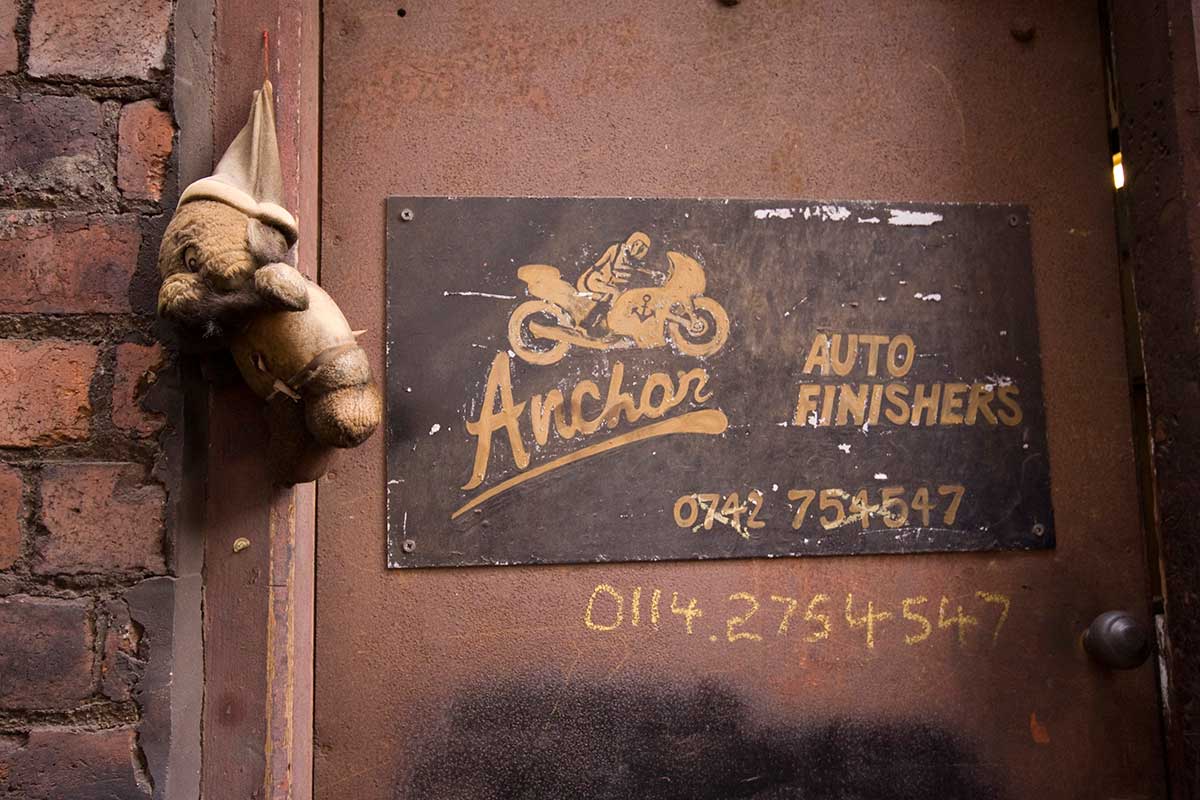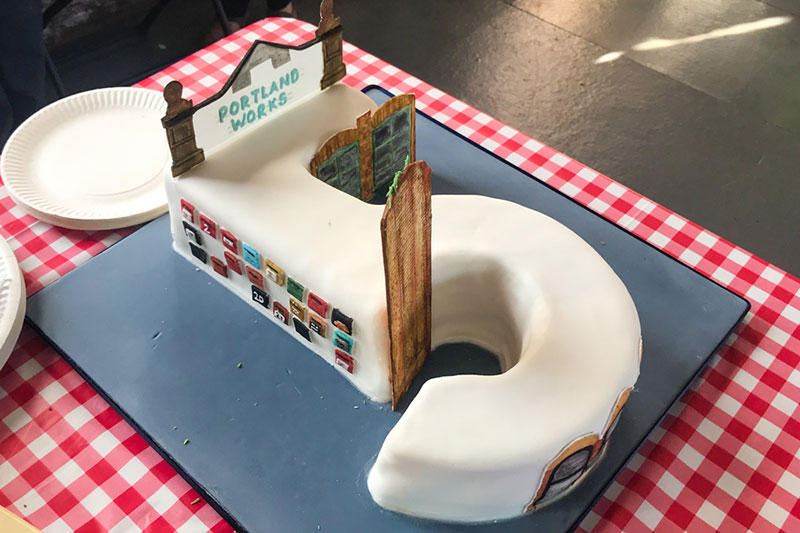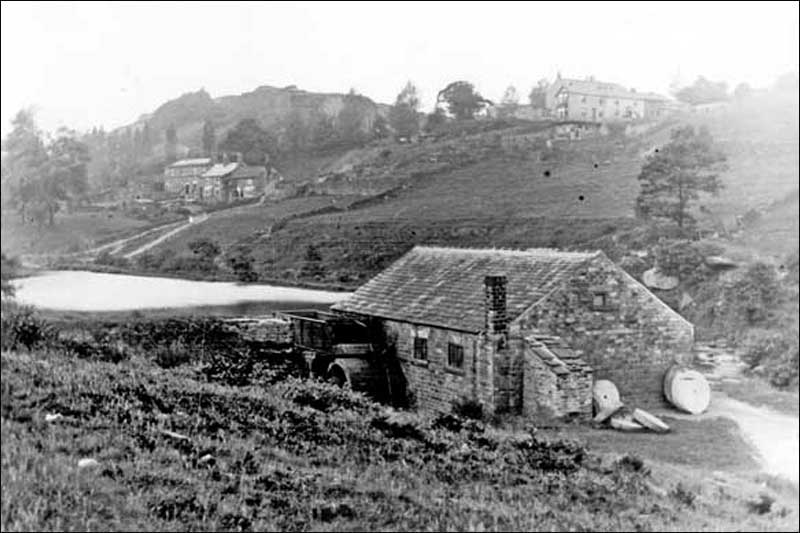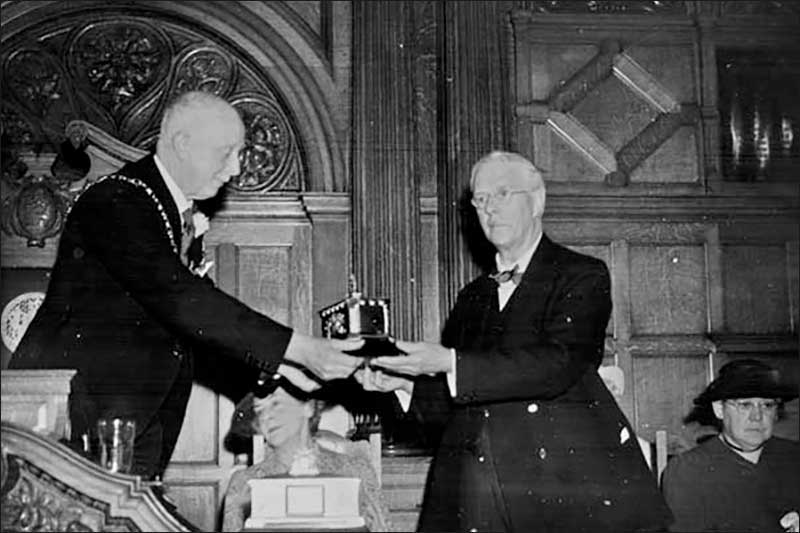January – December 2009, early days
By Julia Udall
Architectural Researcher
Portland Works is a place that captures people’s imagination. Throughout the campaign I have had the pleasure of inviting numerous people to the Works- and each one leaves wanting to tell others about the place and people, and passionate about helping the project succeed. The energy and enthusiasm that people have given has driven the project forward… and made it feel worthwhile, when, late on a Tuesday evening we brave the dark, the drizzle and rumbling stomachs to meet.
The first public meeting, was back in January 2009, initiated by Andy Cole of Wigfull Tools, Cllr Jillian Creasy and myself upon hearing of an initial planning application to convert the works into flats. This drew a large number of people, from the Works, the local Sharrow neighbourhood and from other similar works buildings; each representing what Portland meant to them and their city… and what they felt might be lost. For some this was their livelihood, specialist skills, their heritage… and for others, it was communities, relationships or a cheap space in the city to be creative. This meeting set out a challenge and a responsibility, but also showed us our strength- this place was needed in the city!
The Planning Application was withdrawn in March due to insufficient information and all went quiet… but throughout the summer a former tenant of Potland Works told me stories about the building, shared her knowledge and history of the place, and kept me updated on conversations with English Heritage, the Victorian Society … and her fear that another application may have been around the corner. Andrew Cole also invited MP Richard Caborn and Paul Blomfield to visit, both of whom gave the campaign support. In October 2009 a revised Planning Application was submitted by the landlord and the tenants again became very concerned about their future. The initial aim of the campaign group was to oppose the Planning Application and keep Portland as a place of Work.
December 2009 – December 2010, the Campaign
By Derek Morton, then Chair of Portland Works
I joined the campaign after meeting tenants Stuart Mitchell and Andy Cole at the Galvanised Festival works visit in November 2009. I was impressed with the building and their approach to their work, and appalled to discover the place was threatened with a planning application, which had just been resubmitted. The following week I wrote a letter to the Sheffield Telegraph which was duly printed and following this met up with Julia Udall (Community Architectural Researcher at Sharrow Community Forum) and about a dozen of the tenants at Cafe Euro, just before Christmas.
It was quite an experience – it quickly became clear that there were precious few legal grounds for opposing the application, given the Works’ dilapidated state as an industrial building, and the prospect of renovation through its conversion to flats. Our group, on the other hand, had all grasped that what was proposed at the Works was destruction of ‘living heritage’, and something very special for Sheffield.
The last cutlery works building to be used for manufacturing faced conversion into flats.
The question arose ‘what do we want?’ If the planning application was turned down, the landlord would probably seek to raise rents and, on the evidence of the past, offer very little in return. And how could we get out of the game of just opposing the flats? What could the Works become? It was clear that the building needed a lot of work, how might that be financed?
By the 12 January Julia had organised a public meeting at Sharrow Community Forum – ‘Portland Works Alternative Futures’. The previous meeting had already raised the possibly of buying out the Works to secure its future, and a plan was proposed. This covered a Vision for the future, potential Management and Building Priorities. We saw the Works as a place of crafts and small scale manufacturing. New businesses could be encouraged, the old skills passed on. We would work this up to a business plan to inform all our press, media and political work over the next few months.
The Steering Group was formed as the main focus for action, meeting fortnightly. A core group of about 20 people – tenants and members of the community – led the campaign in a cooperative spirit.We undertook an audit of the Works to see who exactly was working there. It transpired that 35 people were actively using the Works, in 20 businesses and studios, covering a wide range of metal and woodworking trades and creative industries. Almost every unit in the Works was occupied. In fact, far from being under-used and under-occupied the Works was contributing positively to the local economy.
We set up a website to complement the existing blog and facebook page, as a ‘one stop’ place which kept the public up to date and allowed them to contact us. Messages came in from all over the world.
Meanwhile the arts scene was buzzing around the Works – a major photography exhibition in Castle Market through February to April featured the Works and produced a wonderful petition of support, and Bank Street Arts offered space to the Portland artists to promote the cause. Offers of help resulted in a set of vibrant posters of Portland works tenantsWhat followed was a long and grinding process to get press and media attention, acknowledgment from the Council that they might be minded to oppose the planning application, and the gradual construction of a business plan for purchase, management and renovation. Up to Easter the main focus was defeating the planning, after that the planning became less important as delays added up with the owners.
BBC Calendar, Yorkshire Post, Radio Sheffield and the Sheffield Telegraph and Star all ran pieces on the Works. Radio 4 ‘You and Yours’ ran a ten minute piece in May 2011 and we made Sky News. Several tenants became media stars and we’d reached national coverage! The Council came ‘onside’ following a visit by the Council leader Paul Scriven who recognised the Works’ contribution to Sheffield’s history and economy. During May Stuart and I met the landlords and secured an offer in principle to sell the Works to our group, without a price being agreed. It was clear that we’d reached a turning point.
Alan Deadman of Stag Works offered a huge amount of support from an early stage and offered the good offices of the Little Sheffield Development Trust, itself formed to (unsuccessfully) buy out Stag Works some years earlier. Julia’s contacts and hard work with the University led to the Conference / Workshop on 11 June by the Knowledge Transfer Partnership. Its intention was to consider how the Portland Works Campaign groups’ priorities for the future were translated into how the place should be owned and managed. The workshop was also an opportunity to draw in expertise from throughout the city and make stakeholders aware of what was important about Portland Works. The outcome of the day was a decision to form an Industrial Provident Society (Community Benefit) as the preferred model of purchase. The steering group became the Portland Works Committee and an offer of support came in from Cooperative Enterprise Hub to write the formal business plan.
We registered our Community Benefit Society. An “Industrial and Provident Society for the benefit of the community”, it’s an organisation a bit like the Cooperative Group, which is owned by its members, but different in that the benefits will go to the wider community as well as the members who have invested.
Hundreds of people had opposed the flats. Without our protest, the flats would have happened. The landlord was giving us a chance to buy the Works. Here was a real opportunity to get something right, to demonstrate what a community could achieve.
January 2011 – March 2013, from share launch to purchase
By Derek Morton, Then Chair of Portland Works
From January to May 2011 seemed a blur of activity – a team of five wrote a business plan, subjected to endless edits and rewriting and in frenzies of activity bashed it into a coherent shape which could be presented to the world. Our work achieved credibility… In June 2011 I was contacted by Hugh Facey OBE who said “I’ve read your business plan” – few people actually do this! – “and I like it”
We negotiated loans from two sources, the brilliant Architectural Heritage Fund who look out for projects like ours that need a finance package that banks won’t touch… and the equally brilliant Key Fund who look at social enterprises. We were ticking their boxes.
The share launch was on 16 June 2011. A party of several hundred supporters turned up at the works, the wine flowed, the band played, it was a proper sunny evening and we took our first £7,500 of share sales. Press interest was intense and it seemed we were in our way. The money continued to flow in and by September we were at £100,000 and the owners started to notice. We knew we had to make £200,000 to have a hope of negotiating a deal. The money went into a holding account quite separate from our rapidly vanishing campaign account. We thought we’d be there in six months……
Hugh Facey facilitated the negotiations and provided sage advice. As the discussions got under way through the late autumn we struggled to get further with the fundraising, and by January 2012 we were on £115,000, not wonderful. The share offer was due to close in January – we extended it….
Two things then happened. The previous September a film crew had come from the BBC to make Heritage Heroes. We’d forgotten about it… it went out in early February, in the same week that our new PR advisor Philip Strafford, had coordinated a press and media blitz. Our share sales took off again, as people all over the country put in cash – we took over £30,000 from 70 new contacts in six weeks as well as taking £2000 of donations. An open day on a sunny day in March lifted our spirits, it seemed we may really be on the way after all.
The second thing was to make a deal with the owners. Almost at the point of pulling out, when it felt we may not reach the common ground, we agreed a price and a process to get there, thanks very much to Hugh Facey’s efforts.
The deal involved a staged purchase over three years that we could finance with our resources, whilst providing a fair price for the owners – fair to both parties, it was generally agreed. But it was to be another twelve months before we got there. We continued – slowly – to sell shares but seemed to stick short of £200,000. We had a £100,000 loan from AHF, and meanwhile the legal difficulties with the contract just grew, along with the bill.
Finally. towards the end of 2012, we got together again. A ‘final’ cash offer was made and accepted, which meant we had to raise another £100,000. The gamble paid off – shareholders came up with another £40,000 of shares sales and we bridged the gap with a Bond offer to our shareholders – which raised another £60,000. With great speed, the deal was finally completed on the last day of Febnruary 2013, the Works became ours.
Postscript – August 2014
Buying the Works was a long and tortuous business, and it certainly took its toll in personal stress levels of several key members, but the group moved on to the job of running the Works. We’d never done this and despite months of preparation it was hard! Colin Havard was employed as manager – initially for a day a week but soon hiked up to 3.5, and well worth it. He runs the Works and project manages the building projects very capably.
Over a year later and we can say the roof is weatherproofed, the most urgent safety work is done and a large area is being renovated mainly by a wonderful team of volunteers. We’ve been recognised at a national award ceremony by the Heritage Alliance, in December 2013, as Heritage Heroes. It’s fair to say ‘We’re on our way!”. When I walk in through that archway it always puts a smile on my face, I hope it does the same to you …





